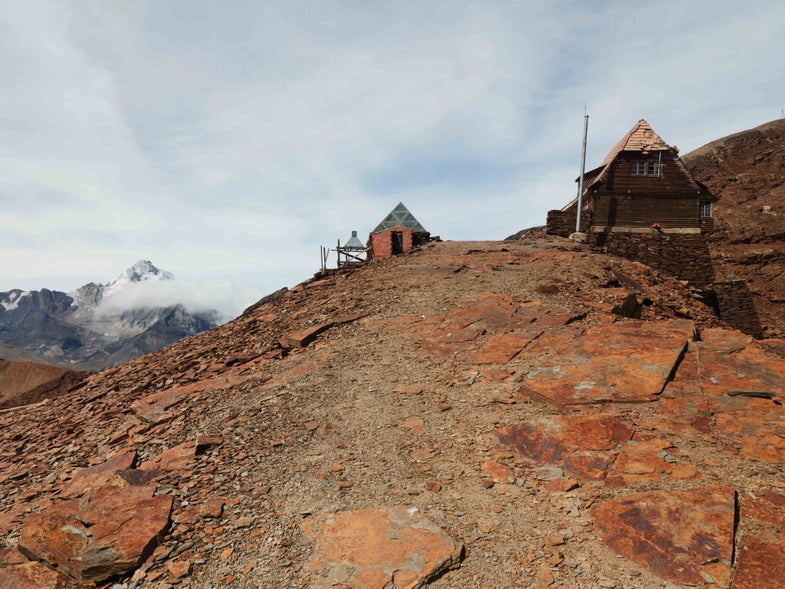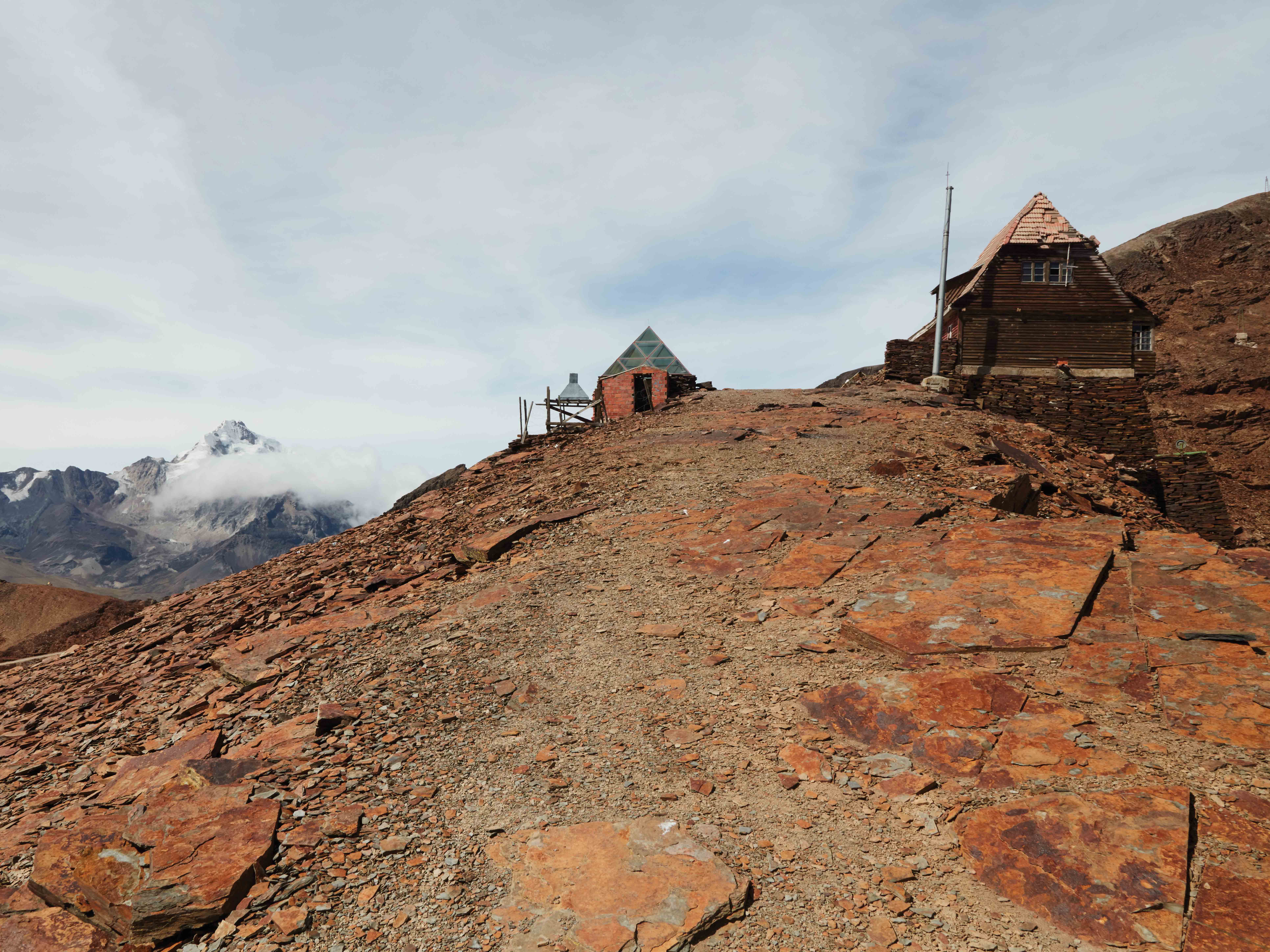La Paz adapts to a world without water
The city is high and dry after losing its glaciers


High and dry
The early-morning sunshine, sharp and unfiltered in the high Andean altitude, flashes off the Water General’s sunglasses. He poses next to a 2,500-gallon tank that his troops placed behind this market of stalls in La Paz, Bolivia. The women who sell here—short, stout, and dressed in the multitiered skirts favored by many of the indigenous—line up with garlands of yellow flowers. The Water General bends so they may sprinkle petals on his head. A crowd of media, assigned to the event, duly take note.
Suddenly a man breaks through the crowd. He screams at the general and the Water Minister, Alexandra Moreira, standing at his side. “It is not enough. You are disrespecting the people!” the man yells. As the general’s troops drag the man out by his arms, he adds, “It’s the truth.” Moreira, in her skinny jeans and a navy-print blouse and suddenly looking far too young for such a weighty position, winces.
At nearly 12,000 feet in altitude, La Paz sits in a zone—the high tropics—suffering the effects of climate change quicker than the rest of us. The glaciers that once fed the city are in retreat; the seasonal rains that should replenish the reservoirs from November through February are increasingly unreliable. In early November, the federal government declared a state of emergency. Overnight, officials cut water to 94 of the city’s neighborhoods, leaving about half of its roughly 800,000 residents caught completely off-guard.
On television, the government promised to turn the taps back on in a day or so. But when the water did not return as promised, hundreds of people protested. They commandeered the cisternas, the tanker trucks brought in to distribute the dwindling water supplies street by street. In one instance, angry citizens questioned local water officials for several hours at a rowdy meeting, refusing to let them leave. That’s when the federal government sent in the Water General, aka Brig. General Mario Enrique Peinado Salas, to suppress unrest and enforce a rationing system.

The general in his labyrinth
But the drought, decades in the making, isn’t so easily solved. As temperatures rose, rivers and lake beds that once nourished fields and crops dried up. Countless farmers and other rural people who relied on the land fled into the cities. There, a woeful lack of infrastructure—a dearth of water-treatment facilities in La Paz, aging reservoirs, leaky pipes—failed to keep pace with the demand.
La Paz has now entered a post-water world, where strict rationing is a way of life for many. For months, some of the city’s neighborhoods received water only once every three days for a few hours. (In mid-January, it increased to every other day.) When water does flow, people rush to fill anything handy—bathtubs, buckets, trash cans—so they can drink and cook and flush until they run out again. The crisis has cut most Bolivians’ meager daily use (an average 48 gallons compared with an American’s daily 100-gallon habit) by two thirds. To cope, people go without nonessential water activities, like laundry and bathing.
Even when water flows, it too often resembles a failed urine sample; it’s streaked with angry orange particles, thanks to pipe gunk and reservoir sediment. Still, piss water is better than no water, which is what you get in the higher-elevation poorer neighborhoods, where the water pressure is just too low.
To survive, most everyone must buy at least some bottled water, a once unthinkable luxury for the poorest people in South America. And they must also rely on the Water General.
Every morning, his troops drive to a dwindling reservoir to fill their fleet of 113 cisternas, each the size of a fuel tanker. They dispatch it gallon by gallon to communal tanks that have popped up on street corners and in plazas. When they arrive, crowds materialize, lugging blue, yellow, and white garbage cans, and keep coming until the trucks are drained.

A drop in their buckets
It doesn’t take much of a leap to imagine a scene from an Isabel Allende or Gabriel García Márquez novel where citizens wake to find their land parched, a mustachioed general holding their water captive. The surreal and real have always co-mingled in Latin America. But while government ineptitude has its place in this story, losing water overnight can no longer be dismissed as a bizarre plotline unique to our southern neighbors.
In fact, a world where generals deliver water—or fight for it—is probably not all that far behind the rest of us. The same forces causing La Paz’s drought are taking their toll on the planet, including in the American Southwest, Central Europe, and China. The great glaciers of the Himalayas—the planet’s largest body of ice outside the polar caps—are slowly disappearing. With them, an important water source for one-sixth of the world’s population is drying up.
The lesson from Bolivia is that it is not difficult to forecast. With a warming planet, there is just not enough snowfall or rain to replenish many of the world’s glaciers. As they disappear, one by one, droughts and water shortages will follow. “They are coming, and I don’t see clear evidence that people are developing policy proactively,” says Martin Sharp. He should know. A professor of Earth and Atmospherics at the University of Alberta in Canada, Sharp studies glacier dynamics, hydrology, and climate-driven changes. He is frustrated that policymakers in Bolivia, Canada, and elsewhere have been so unresponsive to the science and to the coming challenges.
They’d better get moving, Sharp says. “These aren’t problems that you are going to solve over a cup of coffee at Starbucks.”
Nor can you solve it quickly or elegantly once you’re in the midst of it. For weeks after rationing began, Moreira remained in semiseclusion; obviously now is not a relaxed moment to be Water Minister. Her foray to the quiet Sunday market with the Water General is a kind of soft relaunch for her public-relations efforts. “We are working on the problem,” she promises. She also has good news.
The city, she says, has launched four projects to fix its water woes, including an additional dam and reservoir to capture more rainwater and a pipeline to bring water from a creek. But “the weather,” she adds, “is not helping.” Her voice trails off as she gazes upward past the brown mountain peaks in the distance and gets to the real point.
Which is that the sky won’t cooperate.

Have barrel, will wait
For years, scientists predicted that climate change would cause a devastating water shortage in the Andean plain. Like the ominous rumblings of a movie soundtrack before the T. rex appears on-screen, there were persistent warnings. Nongovernmental organizations like Oxfam (2009) and then the Stockholm Environmental Institute (2013) put out increasingly dire pleas for water management. Lake Poopó, whose waters sustained the indigenous Uru-Murato for millennia, dried up last year. At the same time, the normally robust winter rains shrank by more than 25 percent. And through it all, a local paleoglaciologist named Edson Ramirez tried persistently to get someone to act.
A soft-spoken professor at the Institute of Hydraulics and Hydrology of the Higher University of San Andrés in La Paz, Ramirez did not want to be the Cassandra for this catastrophe. But the science left him little choice. In 1998, he began measuring Chacaltaya, a glacier an hour’s drive from the city, which held a world-famous attraction: the world’s highest ski resort. Ramirez expected shrinkage. But the reality surprised even him: Just 15 meters thick, the glacier was disappearing at a rate of at least 1 meter a year. Ramirez calculated it would be gone by 2015. In 2005, he went to city officials to warn them and discuss the consequences for a city that relies on glacial runoff for water. He laid out a dire timeline. The bureaucrats politely listened but were unconvinced. They told him: “Maybe it will happen, but maybe it will not.”
It turned out Ramirez was wrong—but only in his optimism. By 2009, six years ahead of his calculations, the glacier had vanished, leaving nothing but a brown stain. The revelation hit the worldwide media like a storm. But La Paz’s travails are greater than glacier melt. In recent decades, temperatures on Altiplano rose by about 2 degrees Celsius. In the past 15 years, annual rain and snowfall declined by 20 percent. Local water officials say that will fall at least another 10 percent by 2030.
Sitting in his university office, with dust particles hanging in the slats of sunshine that filter in, Ramirez seems neither righteous nor angry that his long-ignored prophecies have come true. Instead, dressed neatly in a crisp and buttoned-up short-sleeve shirt like a Wal-Mart manager, his black hair slicked back, he is intent on getting the government to focus on reacting to what will come next.

Glacial response
Speaking without notes, he methodically lays out the devastation to come. Bolivia is responsible for 0.35 percent of the world’s greenhouse-gas emissions, compared with the United States’ 14.4 percent. But because of Bolivia’s location and elevation, the Andean nation is experiencing the impact of those carbon emissions at a far more accelerated pace than the U.S. The speed of temperature increase has gone from 0.11 degrees Celsius per decade 40 years ago to 0.33 degrees in the last decade, he explains. (The global average is 0.15 to 0.20 per decade.) Climate change has also provoked an increase in the number and strength of El Niño in the Pacific Ocean. In El Niño years, the country gets 20 to 30 percent less rain than what was once the average. But even in non-El Niño years, precipitation comes less frequently and in more-intense bursts, making it more difficult to capture, and harder on farmers and their crops.
And all this leads back to the big ice. The Andes glaciers are relics of the last ice age, which peaked 18,000 years ago. Now these rarities are disappearing rapidly. During the rainy season, a small temperature increase means that instead of snowing in the very high altitudes—which would recharge these giants—it rains, accelerating melt. The result, according to Ramirez, is that 37.4 percent of the tropical glaciers around La Paz liquefied and slid away between 1980 and 2009.
While runoff might provide only 10 to 20 percent of the city’s annual water supply, it has historically played a crucial buffering role during droughts. For example, La Paz’s nearby higher sister city, El Alto, which sits on the towering 19,000-foot Huayna Potosi mountain, still has running water, despite the drought. “In the heat, runoff from Huayna Potosi has increased, causing equilibrium in the system,” Ramirez explains.
A favorite among climbers, the mountain has been reliably covered with snowpack for thousands of years. But even the glacier there, once a thick slab of blue-white ice, is only half of what it was a few decades ago. How long before it too goes? Ramirez does some calculations. “Maybe 40 years,” he says. “Maybe.”
It is a devastating assessment of the region’s water future—well, its entire future. Is there a chance Ramirez would save himself, move out of La Paz? “No.” He shakes his head and smiles gently. He has offered to help the government address the crisis. Has the government accepted? He again shakes his head.
The politics of water in Bolivia are touchy. What Ramirez hints at but will not say is that the government will tolerate only so much criticism; if he is too public in his condemnation and focuses on human mismanagement instead of climate collapse, he might lose grants or other financial support. The silence of what is unsaid fills the room.
Ramirez suddenly pipes up and points out a bright spot in the settling gloom. “The way people think about water is changing,” he says. “Now people are trying to catch the rainwater. I think this is very important.”
After visiting Ramirez, my local guide, Paola, takes me for a trip up to visit the spot where the Chacaltaya glacier once lay. At 17,115 feet, the glacier’s old ski resort perches far above the tree line. In fact, it sits far above the line where anything grows. Without its snow dressing, the barrenness is absolute. The deserted ski lodge and the lift’s old winch add to a haunted atmosphere. Paola, now 41, remembers vividly her mother and grandfather taking her here as a child. I try imagining the shrieking of children and snowball fights instead of the desolate pit of shredded rocks. My reveries are broken by a shout of greetings from a day hiker. He has stripped to a T-shirt because of the heat.

Brown diamonds
Paola is looking off in the near distance, where the 19,000-foot Huayna Potosi looms. She is shocked by its change in appearance. Huge gray granite ridges jut from the snowpack. Perhaps, she conjectures, Ramirez has been too optimistic about that glacier as well.
Bolivia has both a tragic and triumphal history with water. In the 1990s, many of its cities, including La Paz, privatized their water systems, hoping the American and French conglomerates they hired would bring efficiency and expansive service. It worked, but prices climbed; the people rebelled. They booted the corporations. Then, in 2009, Bolivia got a new constitution, one that described water as a fundamental human right. The move also gave the Bolivian government, under President Evo Morales, an international role as defender of this new guarantee.
The reality is far more complicated and shameful. One river that bisects La Paz is so thick with raw sewage and industrial runoff that people won’t touch it, even in a drought. The nationalized utility, ESPAS, which replaced the French company in La Paz, is awash in incompetence. A 2013 audit found that millions of dollars of potential revenue were lost due to leaking hardware. The city’s infrastructure, which is separate, has fared no better. One audit revealed 45 percent of all its water escapes through faulty pipes. New pipes and better oversight could improve the situation—but maybe that is not even enough. One of the insidious qualities of climate change is that it quietly reduces the resiliency of nature until there is far less—or no—room for human error. La Paz seems perched on that precipice of no return. And the city’s leaders still may not have accepted that.
Whiteboards crowd the walls of the Water General’s headquarters, a single vast room of planning and plotting. Here he charts the progress and locales of each of the 113 cisternas at his disposal. He is proud of his efficiency. He brags that the number of daily requests for water have greatly diminished since the height of the crisis. Things seemed to have leveled out. The people are being served. But when asked if his solution—using trucks to take water from the same source that normally feeds the city’s pipes—isn’t a bit like robbing Pedro to pay Pablo, he shrugs. It slows the pace of consumption, he explains. Asked how much water is left, he says confidently: “We have 10 days. And soon it will rain.”
Two days of dry weather later, and under clear skies, the Water General and the Water Minister lead a caravan of four-wheel drives into the mountains to show reporters two new construction projects. One is a pipeline that will raid water from a nearby “creek” at the rate of 200 liters per second. That creek, however, is the water supply for local farmers. As their land dries up, they’ll move to La Paz, further taxing the city’s water system.
We leave the caravan to travel another 45 minutes down a dusty and rock-strewn road to a vast dam/reservoir construction project that Moreira has told us about. It’s just upstream from the old dam and looks like workers slapped it up overnight. “It will be operational by mid-January,” Moreira pledged. It seems improbable the government will make that deadline—and irrelevant. The evening before, Oscar Meave, the coordinator of the technical unit of dams in the ministry of water resources and irrigation, had already explained the problem. While the new reservoir will be capable of holding much more water than the old one, it will probably take two rainy seasons to fill it.

Who’ll start the rain?
Being a technical man and not a politician, he says what they will not: This season is a disaster, down 40 percent in its first month.
Back in the city, the people of La Paz do what all humans do in the face of a slow-motion disaster: adjust. On a Friday afternoon, Katherine Sanchez Lopez, a 43-year-old public-relations professional, sits in her two-story home in an upscale neighborhood. Santa Claus figurines perch on cabinets and a stairway landing, ready to greet Christmas with a cheery face. In other circumstances, the house might be described as tidy. These days, buckets and pots of all shapes and sizes, filled with water, perch on counters, hide behind chairs, and crowd the bathrooms. The seven people who live here use them for flushing, cooking, and sponge bathing.
It is 1 p.m. on a workday. Before the crisis began, Lopez would have been in her office downtown. Now she sits at home hoping the city will turn on her taps so she can do laundry. Piles dot the floor. The city said it would turn on her water at 9 a.m. and leave it on for five hours. Lopez checks her faucets again, turning them uselessly. Still nothing. Everything is “totally, totally different,” she says. “We have to spend so much time waiting.” She wears a pink sweater and a festive red bow in her hair. But her demeanor does not match her upbeat dress. “I wish we had been warned,” she adds. “We could have acted more consciously about water.” It is too late now, she seems to say, with a shake of her bow. “Now, I think it is the way we will have to live for a long time.”
This article was originally published in the March/April 2017 issue of Popular Science, under the title “High and Dry.”